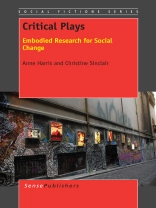Critical Plays is the systematic study of one (fictional) classroom culture populated by six students and their two professors, imaginatively conceived from interviews, experience, observation and thematic analysis, and shaped into performance text. This play-as-research-text aims to provide an encounter both creative and scholarly for readers. The characters who populate it are drawn from the authors’ lived experiences as researchers, teachers, and performance makers. The characters are drawn from the fields of health, performance studies, education and leadership studies to remind readers of the political, social and scholarly power of creative research approaches. The text also attests to the potential of integrating emotion and relationality in the research space. This text is a must-read for qualitative researchers and students of health sciences, communications, interdisciplinary ethnography, rhetoric, education, sociology, drama and theatre arts. Relevant to the lives of an emerging generation of researchers and students, this text highlights new methodological pathways that are open to them as they begin their own scholarly undertakings in a rapidly-evolving global research landscape. It also poses serious questions about education, identity and creativity that readers can reflect on. Written with humor and passion, students will enjoy reading excerpts aloud in class, or on their own. This play can be read or performed purely for pleasure, or used as a class text in courses that address qualitative research methods, performance studies, education, teacher training, pedagogy and curriculum, arts-informed inquiry and research ethics.
Anne Harris, Ph D is a playwright and scholar who addresses themes of diversity, creativity and gender in her work.
Chris Sinclair is Head of drama education at the University of Melbourne. She is also a freelance community artist who draws on research in her arts practice and the arts in herresearch.
Tabella dei contenuti
Acknowledgements; Introduction; Cast of characters and setting; Prologue; Scene / class 1: Subjectivities; Scene / class 2: Cognitive / creative tensions, or what I know versus what I feel; Intermezzo 1: Miscommunications; Scene / class 3: Truth and verisimilitude. 5:08pm; Intermezzo 2: Dusting down the muse; Scene / class 4: Finding the form; Intermezzo 3: One way or another; Scene / class 5: Telling stories (whose stories?); Scene / class 6: Questions of representation; Intermezzo 4: Art as truth? Holding on to the muse; Scene 7: Researcher as artist / artist as researcher; Scene / class 8: Dotting the I’s and crossing the T’s – Rigour or rigor mortis?; Scene / class 9: Muse or museum? Theory on the street; Intermezzo 5: Between a rock and a hard place; Scene / class 10: Contested territories. When blurring the boundaries means crossing the line; Scene 11: Class notes; Scene / class 12: Critical plays; Scene 13: Coda; Additional reading; About the authors.












